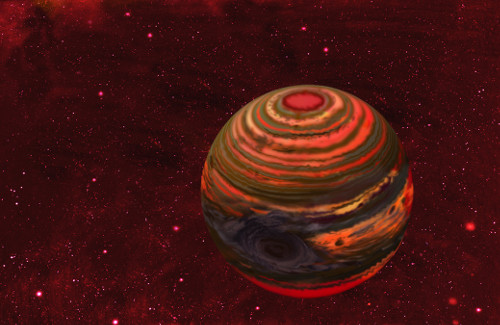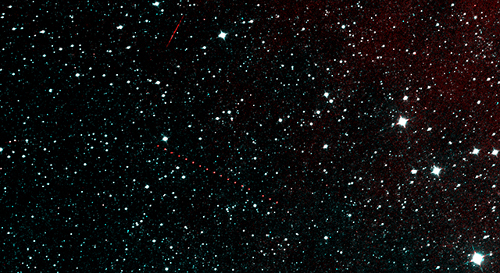I will admit to an obsession with small, dim stars, one that goes far enough to take in those not-quite stars called brown dwarfs, objects too small to ignite hydrogen fusion. The WISE mission showed us that, at least in our Sun’s neighborhood, brown dwarfs aren’t as common as we once thought, with perhaps one of them for every six main sequence stars. For their part, red dwarfs are the prime currency of the galaxy, accounting for 75 to 80 percent of all stars, so between the two we have a host of venues for planets and, possibly, life. But so much needs to be done before we’ll know if either brown or red dwarfs could really be candidates for astrobiology around them.
These thoughts are triggered by more news from WISE, now in its reactivated incarnation as NEOWISE (Near-Earth Object Wide-field Infrared Survey Explorer). The spacecraft came back to life in September after 31 months of hibernation and is now working to help us identify potentially hazardous near-Earth objects, a reminder that brown dwarfs were only a part of a much larger mission to characterize the infrared sky. But before I leave brown dwarfs today, let me run an image Greg Benford passed along, a Jon Lomberg conception of a brown dwarf.

Image: Could a brown dwarf like this form planets that support life? Credit: Jon Lomberg.
If memory serves, I ran this image a long time ago in the course of another brown dwarf discussion, and Greg and I talked about it at the first 100 Year Starship Symposium in Orlando. The Lomberg artwork was on Greg’s mind when he finished his recent story “The Man Who Sold the Stars” (in Starship Century) with a scene set around a dim brown dwarf that was only discovered after a renewed search of old data, including that of the WISE mission. Greg describes a surreal landscape on a planet orbiting the brown dwarf called Redstar:
Stars shone in pale gray here against the inky black. The huge hull of Redstar hung as a burgundy disk cut off by the sea. Here and there across the long panorama of perpetual twilight, slanting rays of a deep Indian red showed floating plants, lapping on the waves in a somber sprawl. Everything glowed with infernal incandescence…. Down from the desolate slope to his left came an echoing cry, long and slow. In the thick air a thing like a huge orange gossamer butterfly fluttered on a thin wind. It swooped across a sky peppered with amber clouds and vanished with deliberate, long flaps of its enormous wings, vanishing behind a low eroded hill.
As we learn more about dim stars and much dimmer brown dwarfs, we have to answer key questions that impinge upon their chances for such life. About red dwarfs, we have to learn whether tidal lock offers stable meteorology anywhere on the surface (various papers have argued that it can), and whether the flare activity particularly in young stars would sterilize the planet or serve as a spur to evolutionary change. About brown dwarfs we have to learn whether these continually cooling objects produce rocky planets in close orbits that could stay warm long enough for life to thrive.
NEOWISE Surveys the Nearby Sky
We won’t have the answers to these questions any time soon. For this morning, then, back to NEOWISE. The image below shows a view from the spacecraft after its recent reactivation. If you’ll study the center of the image, you’ll see the track of an asteroid as captured in a series of exposures. This image shows an area in the constellation Pisces; the asteroid is (872) Holda. A red streak at the top of the image is the track of an Earth-orbiting satellite.

Image: NEOWISE originated as WISE (Wide-field Infrared Survey Explorer), which was put into hibernation in 2011 upon completing its goal of surveying the entire sky in infrared light. WISE cataloged three quarters of a billion objects, including asteroids, stars and galaxies. In August 2013, NASA decided to reinstate the spacecraft on a mission to find and characterize more asteroids. Credit: NASA/JPL.
From 2010 to early 2011, NEOWISE discovered more than 34,000 asteroids and characterized 158,000 throughout the Solar System. Amy Mainzer, principal investigator for NEOWISE at JPL, looks at the future of the mission:
“NEOWISE not only gives us a better understanding of the asteroids and comets we study directly, but it will help us refine our concepts and mission operation plans for future, space-based near-Earth object cataloging missions. The spacecraft is in excellent health, and the new images look just as good as they were before hibernation. Over the next weeks and months we will be gearing up our ground-based data processing and expect to get back into the asteroid hunting business, and acquire our first previously undiscovered space rock, in the next few months.”
NEOWISE uses a 40-centimeter telescope and infrared cameras in going about its work studying asteroid size, albedo, reflectivity and other properties. The original WISE mission captured more than 2.7 million images in various infrared wavelengths and catalogued well over 700 million objects. The primary goal of NEOWISE is to study asteroids and comets that approach within 45 million kilometers. It’s exciting and necessary work, but I do wish we had a second WISE working on brown dwarfs.



Astronomers still puzzle over low surface brightness galaxies
Full article here:
http://www.forbes.com/sites/brucedorminey/2013/12/22/astronomers-still-puzzle-over-low-surface-brightness-galaxies/
A subject worth pursuing….because someone once said: Life will find a way….five little words worth keeping in mind….JDS
Pardon my ignorance, but I thought only stars undergoing H2 fusion at their cores created flares?. I can understand a brown dwarf lashing any planet close enough, with a powerful radiation belt.
Could a brown dwarf really radiate enough energy to keep a terrestrial
planets’, average global temps above O celsius. Would It have to be one close in mass to a bonafide Red Dwarf, as I read that those glow more intensly. We should probably rule out brown dwarfs with less than 25 Jupiter masses, as they wound’t provide enough energy to inject into an orbiting planet.
If terrestrial worlds orbiting these ‘stars’ can maintain liquid oceans, then yes some type of life could emerge. But the type of life I think would emerge will be driven at first by volcanism, assusming such planet has techtonic plates. On shallow seas one can imagine an evolutionary race to claim the additonal bounty provided by a brown dwarfs’ heating. The question is, is this extra energy translated to life enough to sustain large animals, and will the radiation belt eventually destroy the atmosphere and seas of this nascent world. Maybe a superterrestrial would do better here.
A possibility that I find intriguing about these dwarves is that they are themselves a potential niche for life: Some of these have surface temperatures that are below 800K and possibly even as low as 400k for old ones, which is a range that could be survivable for complex chemistry. Also, the heat would create convection currents that would bring heavy elements to the star surface, enabling an environment for organic chemistry to develop.
I painted this image for Ray Jayawardhana of the University of Toronto, whose student observed what was interpreted as a large dark spot on the brown dwarf.
@CharlesJQuarra
‘A possibility that I find intriguing about these dwarves is that they are themselves a potential niche for life: Some of these have surface temperatures that are below 800K and possibly even as low as 400k for old ones…’
Brown Dwarfs can have densities approaching that of platinum and no far below the top clouds it will be really hot with a steep thermocline as hydrogen, helium and methane are greenhouse gases.
@Rob Flores – a brown dwarf can produce x-ray flares if it has a strong magnetic field and a rapid rotation. They probably only happen in young, more massive brown dwarfs.
The larger BDs can have a surface temperature of around 2500K, which is just a little redder than a regular incandescent bulb. They’re emitting most of their radiation in the IR, so they may be able to keep a close-in planet warm for a while. Some of the less massive or older BD are going to have temperatures well under 1500K; like a candle or a sunset. A world around a 500K BD would be pretty dim to human eyes, though.
Would there really be much difference between a ‘traditional’ flare generated by an M dwarf and a ‘flare-like super aurora’ generated by what presumably is the very powerful magnetic field of a rapidly rotating brown dwarf?
I remain hopeful that Luhman 16 is going to be a goldmine in this area over the next few years
p
Spitzer Probes Weather on Brown Dwarfs
Posted January 7, 2014 12:06 PM
Swirling, stormy clouds may be ever-present on cool celestial orbs called brown dwarfs. New observations from NASA’s Spitzer Space Telescope suggest that most brown dwarfs are roiling with one or more planet-size storms akin to Jupiter’s “Great Red Spot.”
“As the brown dwarfs spin on their axis, the alternation of what we think are cloud-free and cloudy regions produces a periodic brightness variation that we can observe,” said Stanimir Metchev of the University of Western Ontario, Canada. “These are signs of patchiness in the cloud cover.”
Metchev is principal investigator of the brown dwarf research. The results were presented at a news conference today at the 223rd annual meeting of the American Astronomical Society in Washington by Metchev’s colleague, Aren Heinze, of Stony Brook University, New York.
Full article here:
http://astrobiology.com/2014/01/spitzer-probes-weather-on-brown-dwarfs.html